Family : Picidae

Text © Dr. Gianfranco Colombo

English translation by Mario Beltramini
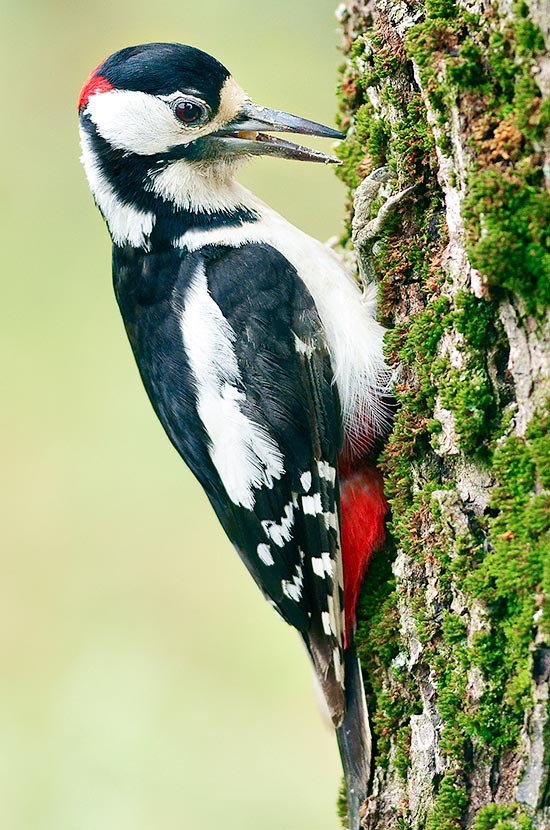
The Great spotted woodpecker (Dendrocopos major) is common in Europe, but Iceland, Ireland and most of the Sicily and Greece. Through Russia, it then reaches China © Alvaro Dellera
Who does not recall Woody Woodpecker, that so snobbish woodpecker, funny cartoon character of Walt Disney that demolishes with its beak everything that is on its way to please its girlfriend, Winnie Woodpecker?
And the woodpeckers characters of two italian children’s tales “Picchio e Piripicchio” and “Picchio e Papicchio”?
And Ferao, the scarler woodpecker, of Kipling’s Jungle Book?
From ancient times come to us tales ans historical news telling us how this bird was already important in the remote times. The name given to the people of the Picentes, that the Romans called “quelli del picchio” = those of the woodpecker, had rightly this derivation.
Or the story of the Roman jurist Tuberon, on whose head one day a great spotted woodpecker perched and in the doubt whether to dislodge it or not, got by the seers two draconian solutions: to cast it out and Rome would end up in ruins or to kill it and in this case he himself would immediately die. For love for his country, he chose the second solution.
A legend that might have inspired, more than a thousand years later, that of the Common ravens (Corvus corax) “imprisoned” in the Tower of London in England. Had they fled or were they dead, the Anglo-Saxon Kingdom would soon disappear.
Finally, also every day normality has been involved by this nice bird and a famous tongue-twister, often repeated by the English children but used also by the foreign students while perfecting their language, sees it leading man.
How much wood, would a woodpecker peck, if a woodpecker would peck wood? An excellent exercise for gaining fluency in their language and an immediate image of what is a woodpecker.
The Great spotted woodpecker (Dendrocopos major Linnaeus, 1758) belongs to the order of the Piciformes and to the family of the Picidae and can be considered as the most common and diffused woodpecker in Europe.
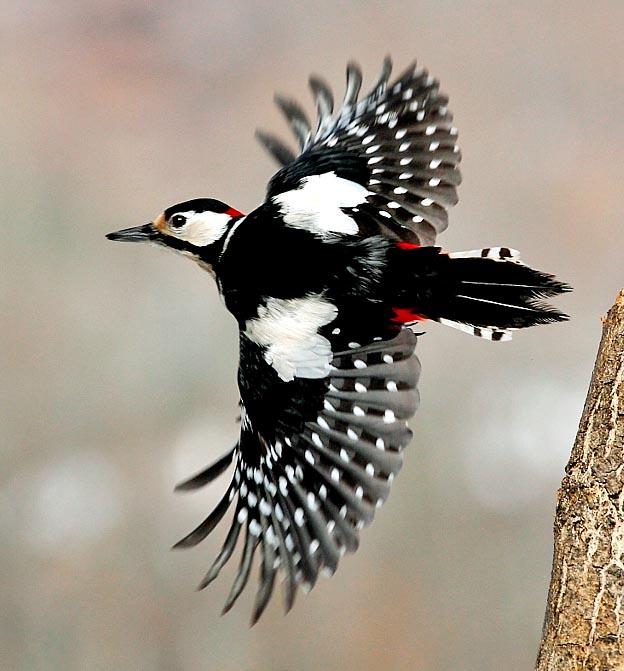
The size of a blackbird, with 40 cm of wingspan © Mauro Pallais
In Europe, it is called Great spotted woodpecker or Greater pied woodpecker = in English, Buntspecht = in German, Pico picapinos = in Spanish, Pic épeiche = in French, Picchio rosso maggiore = in Italian and Pica pau malhado grande in Portuguese.
The etymology of the scientific binomen is fairly simple and exemplifying.
The genus Dendrocopos comes from the Greek “dendron” = tree and “kopos” = to hit; the specific name major from the Latin greater, in order to distinguish it from the Dendrocopos minor, its minor cousin.
Zoogeography
It occupies the whole Europe excepting Iceland, Ireland, part of Sicily and of Greece where it is quite rare.
Also the Scandinavian Peninsula is almost totally occupied reaching therefore very high latitudes.
The same cool temperate belt continues also in Asia through Russia and Siberia, reaching Kamchatka in the northernmost point and occupying totally China southward. Are totally excluded the central part of the Asian continent and the Indian/Indo Chinese subcontinent. In Anatolia and in Iran, where it is absent, it is replaced by the almost identical Syrian woodpecker (Dendrocopos syriacus) with which, however, it shares the Balkan Peninsula.
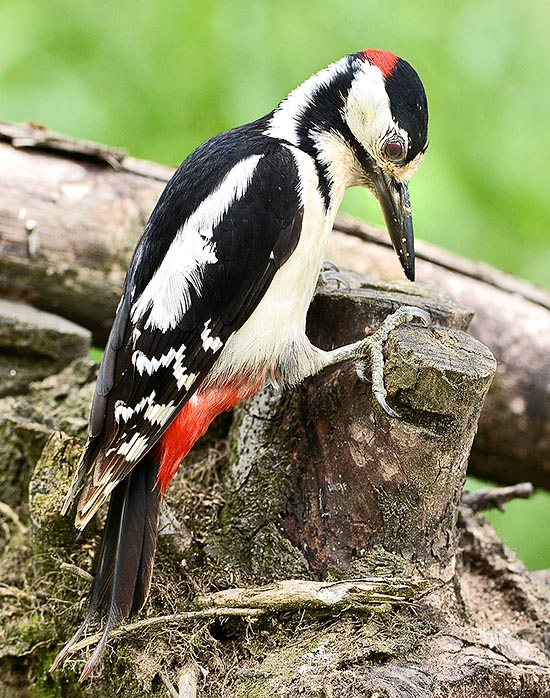
The male distinguishes at once from the female due to the red spot on the head © Alvaro Dellera
The great spotted woodpecker is usually sedentary at our latitudes even if we see seasonal invasions in the northernmost part of the continent. Also in the sub-Alpine valleys and in the Po Valley, in late fall, we see good passages of this species with substantial increases of the local population.
Ecology-Habitat
The great spotted woodpecker is an inhabitant of the broadleaf forests but also of conifers and does not disdain other habitats among which the cultivated open country, surrounded by tree lines, alluvial plantations, poplar groves, old gardens and vast city parks and is, during the last decades, in continuous expansion after a period of sharp declines.
Though originally inhabitant of woods, this woodpecker has nowadays conquered all the urban green and it is not rare to see it on the trunk dominating the park bench on which we regularly seat while it is busy in digging the nest or scouring inch by inch and with unthinkable skill its bark looking for some larvae.
Often we see it still at the same place for some minutes while it turns the head as if trying to lay the ear on the trunk to hear possible presences.
Actually, the woodpecker has an exceptional hearing that allows him to hear through the bark, the least noise caused by the movement of some larva hidden beneath.
Once its presence is ascertained here we get it that with precision starts digging the wood rightly in the point where from the noise comes, and, inserted the long tongue, immediately enjoying the coveted prey.
The proverbial privacy of the woodpeckers has by sure reached the lowest levels in this member and its coexistence with the human activities is nowadays constant everywhere in its range.
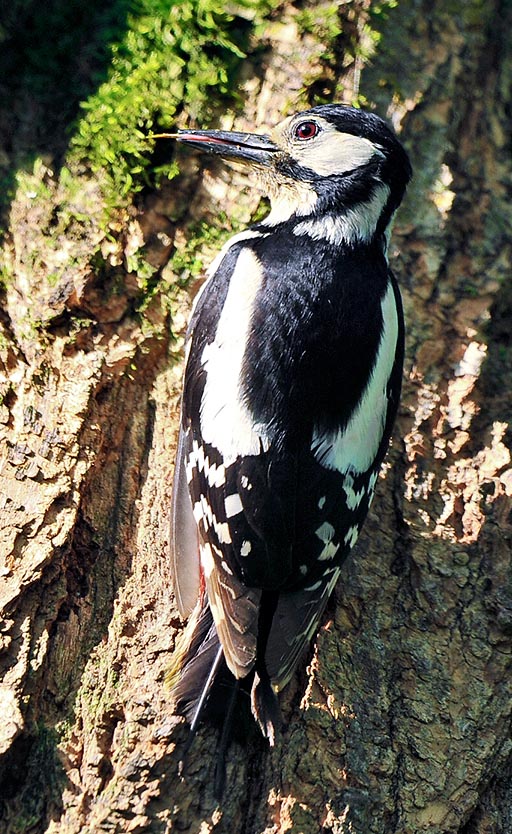
The long viscous tongue seizes in the wood larvae and insects, the diet main dish © Gianfranco Colombo
Often, it does not even go away, but prefers to play hide and seek from behind the trunk and keeping motionless when we pass by.
It is now usually seen also at the winter mangers that are placed in the gardens for attracting hungry small birds.
Knowing its greediness for fatty and oily foods, the great spotted woodpecker is easily attracted by a piece of lard or of tallow dangling from a rope or wedged between the branches of a tree, in which slips repeatedly and with unimaginable ease its beak taking away delicious high in calories morsels.
We can recall the proverb …the cat goes so often to the lard… but in this case it is actually the woodpecker that, known the position of this delicacy, it is so much attracted by it that remains constantly on the spot without ever leaving the position.
On the other hand, the only competitors are the small tits (Parus spp.) that nothing can do against its preponderance.
But its presence is definitely confirmed by the drumming on the trunks, continuous and ceaseless in almost all seasons.
Already since the late winter but more assiduously during the very first months of spring, the wood gets full of its more or less noisy elaborate percussions depending on the trunk chosen.
At times, the “drum” is a dry and tapered branch on the extreme top of a tree, reason why the toll is very loud and high in the tone, other times is a great empty or decaying trunk that emits a gloomy and low echo, others again the live trunk on which it will decide then to seriously dig the nest.
By sure, the great spotted woodpecker is one of the nosiest of its genus.
In a study presented by a Canadian scholar, based on the Intelligence Quotient of the birds, in particular about the methods of research of the food, the woodpecker has resulted as being one of the most intelligent species.
It is perhaps this feature that has led it to evolve and to accept, more than any other bird, the fast changes of the modern life.
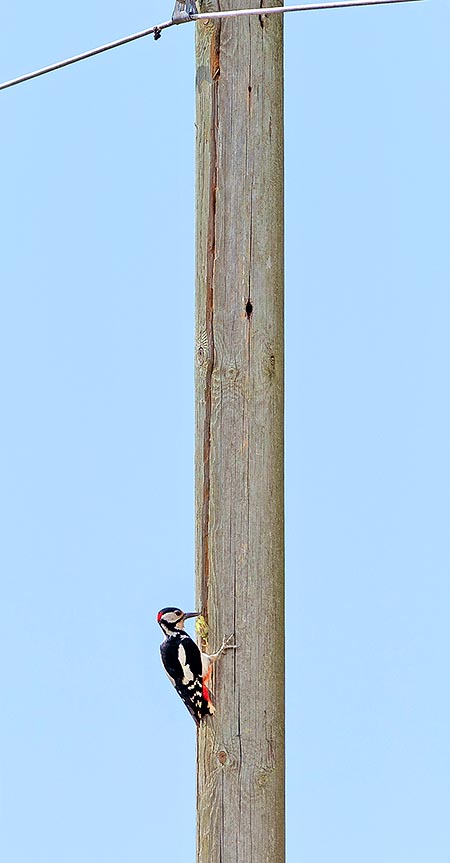
Well anthropized, the Dendrocopos major attacks now also the telephone poles © Gianfranco Colombo
This capacity it has, is often exploited abnormally in particular during the feeding period of the progeny.
In fact through the bark it can easily hear even the least noise emitted by nestlings of other birds that nidify in very narrow cracks or holes where it is not able to look nor even less to enter and therefore it does not hesitate to dig another hole just in correspondence of the bottom of the nest and take off, one at a time, the chicks of other hatchings that will be used for feeding its own chicks. Primary victims are the various tits but also Wood nuthatches (Sitta europaea) treecreepers (Certhia sp.) and starlings (Sturnus vulgaris).
Actually, it is not rare to see these holes imperfect but sufficient enough to allow the head and the terrible beak of these woodpeckers to get through close to other holes visibly frequented by other birds.
Also the nesting boxes are subject to hammerings and are often literally destroyed by the fury of these beaks.
And the work does not end here! The advent in these last decades of artificial materials such as plastics, gummy and elastic wall coverings, architectural beams in exotic wood or even wood sculptures placed in public gardens, are becoming for this bird an inexplicable and irresistible attraction. Its signature is nowadays present everywhere.
Only by late autumn and during the winter, it modifies its way of feeding carrying a bigger quantity of berries, seeds and acorns it stores in the winter dorms.
The woodpecker uses in fact various hollows in its territory and exploits them as occasional dormitories as well as for nidifying when the moment comes. Under this point of view it should not need to migrate until when its food supplies remain abundant, nevertheless some populations effect those errations we were previously talking of.
Morpho-Physiology
The great spotted woodpecker has the same size as a common blackbird, having a length of 25 cm, a weight of 70/90 g and a wingspan of about 40 cm.
In our common terminology it is called great in order to distinguish if from the lesser Spotted woodpecker (Dendrocopos minor) a congener with which it shares part of the range but that does not exceed the size of a sparrow.
It has black upperpart with white shoulders and crossed, on the remiges, by lines and spotting always of white colour. The tail is totally black and like all true woodpeckers, the feathers have vary rigid calami suitable for leaning when hanging on the trunks.
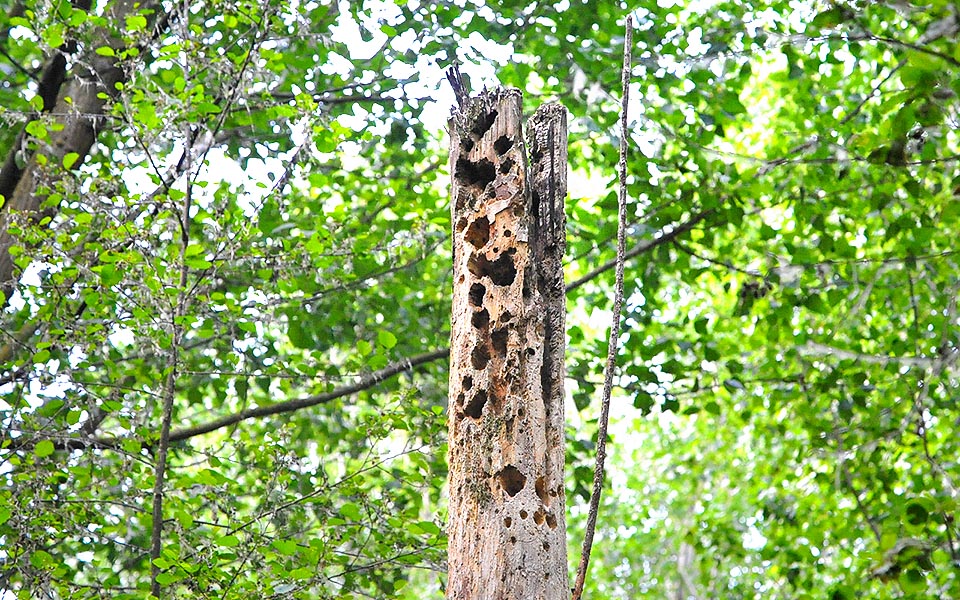
It can easily reduce them badly, like this stroreroom tree of the forest where it piles up acorns, seeds and berries for the winter © Gianfranco Colombo
In the male the head is wholly black with a short carmine red stripe placed on the nape, this characteristic being absent in the female. The feathers of the under tail are on the contrary for both sexes of the same red colour. Black legs and pearly black beak.
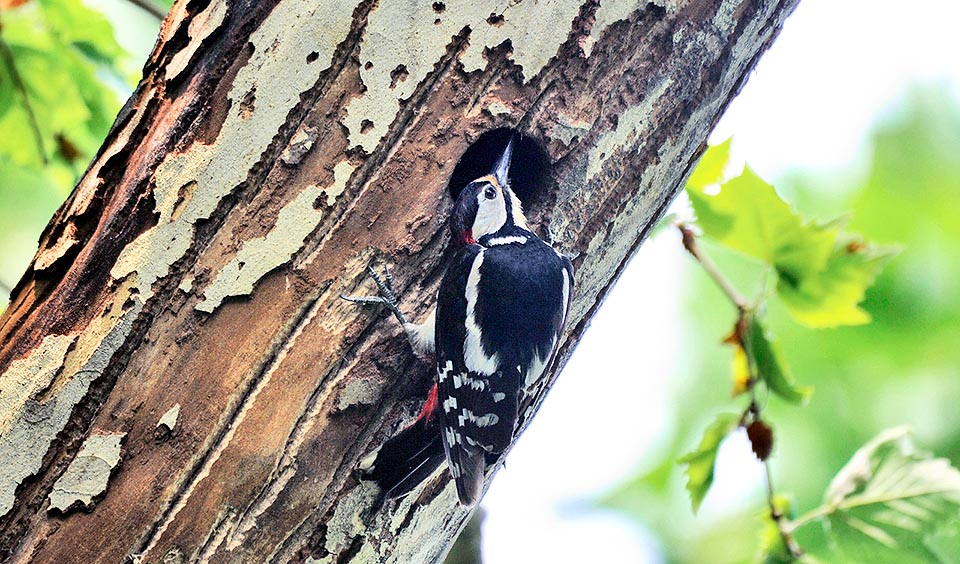
This male digs the nest, usually at 8-10 m of height, with a 5 cm opening. After a short horizontal corridor, we access down to an ample chamber © Gianfranco Colombo
In the young specimens the red colour is much stronger and manifests in both sexes on the head and just nuanced on the undertail. When flying, it presents like a white black bird with waddling gait with very deep drops on the flight line and almost always accompanied by the typical cry.
Ethology-Reproductive Biology
The great spotted woodpecker is a solitary bird and gets close to its consimilars only during the maring season.
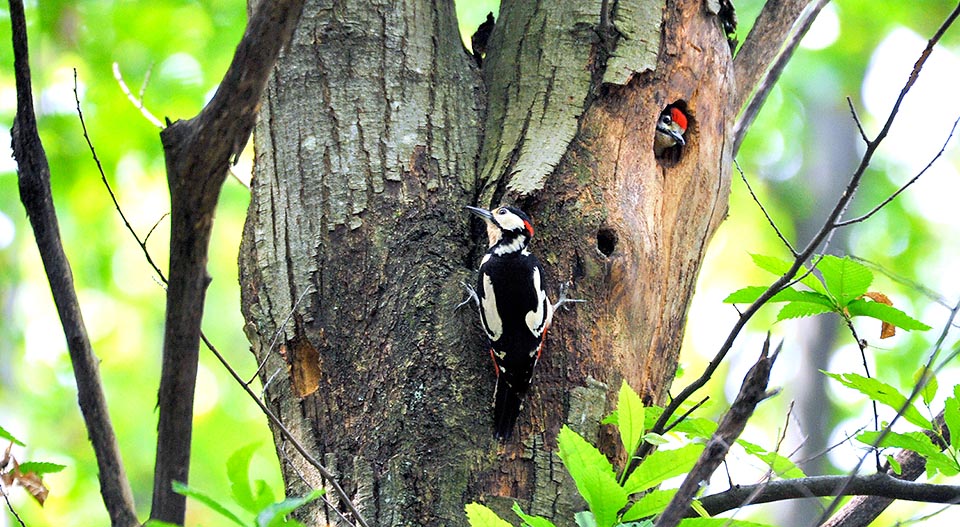
Another male close to the chick in the stillness of the forest © Gianfranco Colombo
Nevertheless, the couple, as customary for the woodpeckers, is faithful only during the nidification season.
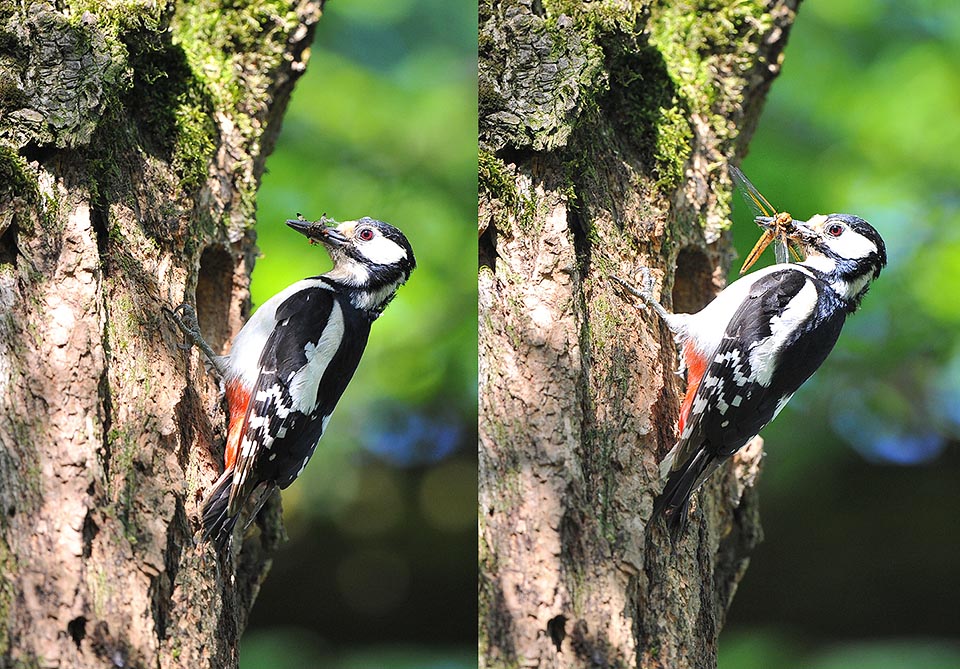
One more nest with chicks to feed. The female takes any sort of prey, at times even just born small birds, killed by holing from behind the trunks that host them © Gianfranco Colombo
The nest of the great spotted woodpecker can be located at any height seen that it digs it wherever it wants. It can be at 2 m of height as well as at 20 m and in any type of essence. Usually, it is placed at around 8-10 m of height.
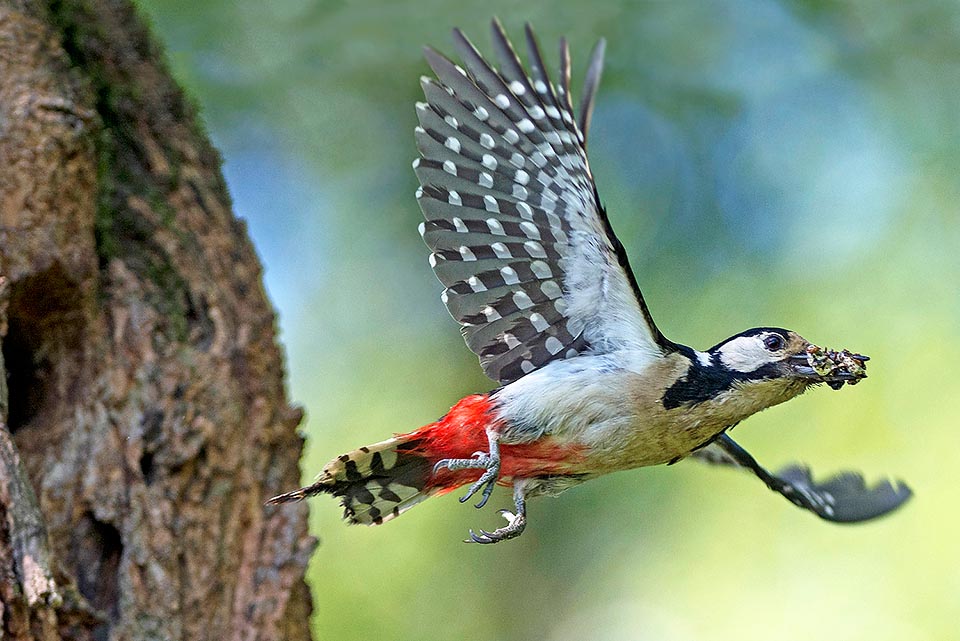
Finally, like a good housewife, it regularly cares the cleaning, carrying out droppings and leftovers © Gianfranco Colombo
The hole is made by both partners and has a diameter of 5 cm. The excavation, after a short straight line of a ten of cm, bends downwards forming an ampler chamber where the progeny will grow up.
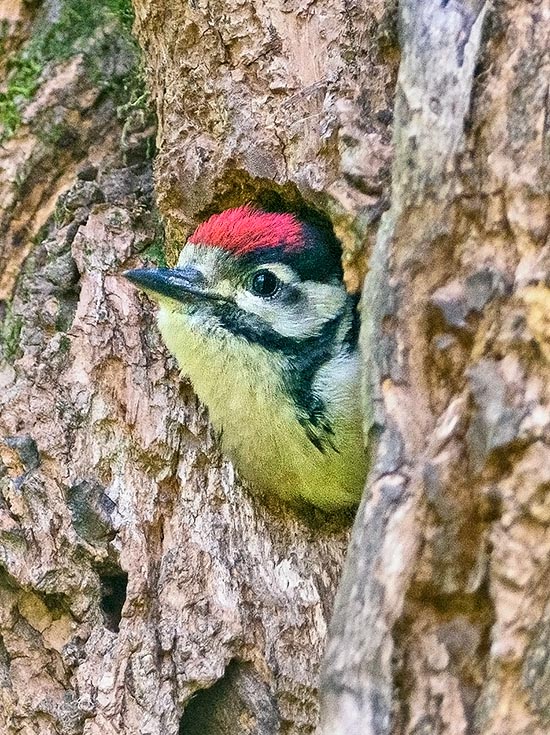
The eggs are hatched alternately by the parents. The chiks stay in the nest for about 3 weeks and then toddle around, still nourished by the parents till when they learn to fly © G. Colombo
It does only one annual hatching but lays again in case of failure of the first deposition.
The chicks remain in the nest for about three weeks, after which they begin to toddle out of the nest climbing all around but always depending from the parents.
At the fledging they are almost always already independent even if the maturity is reached by the second year.
The great spotted woodpecker is well distributed and has a considerable presence in the inhabited ranges therefore it is not considered as an endangered species even if amply protected in all countries.
It has never been considered as a huntable species but among hunters they use to say, even if this bird has never entered in any way their game bag, that the flesh of the great spotted woodpecker stands among the hardest and sourest of all birds.
In the only European continent there is an estimated nidifying population exceeding the 15 million of couples totaling not less than 45 million of specimens.
A curiosity: its easy frequentation of the anthropized environments has led this bird, more than any other woodpecker, to dig holes and at times even the nest in the old wooden poles of the telephone lines crossing our countries.
At times this habit and the continuous obstinacy cause significant damages weakening the hold of these supports up to their collapse.
Synonyms
Picus major Linnaeus, 1758.
